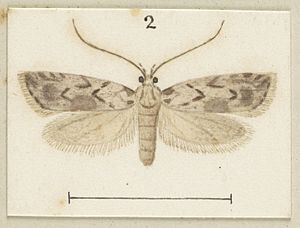Izatha apodoxa facts for kids
Quick facts for kids Izatha apodoxa |
|
|---|---|
 |
|
| Scientific classification | |
| Kingdom: | |
| Phylum: | |
| Class: | |
| Order: | |
| Family: |
Oecophoridae
|
| Genus: | |
| Species: |
I. apodoxa
|
| Binomial name | |
| Izatha apodoxa (Meyrick, 1888)
|
|
| Synonyms | |
|
|
Izatha apodoxa is a special kind of moth that belongs to the Oecophoridae family. It is found only in New Zealand, which means it is endemic there. You can find this moth in different places across the southern North Island.
This moth is quite interesting because it can look very different! It comes in two main forms: one is mostly grey, and the other is black and white. The grey form looks a lot like another moth called I. notodoxa. The black and white form looks similar to I. katadiktya. Scientists are still learning about this moth, as its larvae (caterpillars) and how it lives are not yet known.
Contents
Discovering Izatha apodoxa
Edward Meyrick, a scientist, was the first to describe this moth in 1888. He used moths collected by A. Purdie and George Hudson in Wellington. Meyrick first named it Semiocosma apodoxa. Later, in 1928, George Hudson wrote about and showed pictures of this moth using its current name, I. apodoxa. The main specimen, called a lectotype, is kept at the Natural History Museum, London.
What Izatha apodoxa Looks Like
These moths are fairly small. Their wingspan (how wide their wings are when spread out) is about 20.5 to 26.5 millimeters for males. Females are usually around 21 millimeters wide.
Two Forms of the Moth
I. apodoxa can look very different from one moth to another, especially on its front wings. As mentioned, it has two main looks:
- The Grey Form: This form has faint markings and looks a lot like I. notodoxa. It's hard to tell these two species apart just by looking at them. However, scientists can tell them apart by looking at the male moth's special body parts. Also, I. apodoxa is only found in the North Island, while I. notodoxa lives in the South Island.
- The Black and White Form: This form looks similar to I. katadiktya. To tell them apart, scientists look at a specific patch on the front wing near the base. In I. apodoxa, this patch usually doesn't have a pale spot underneath it. But in I. katadiktya, it almost always has a white or light grey patch.
Where Izatha apodoxa Lives
This moth is found only in New Zealand. It lives in the North Island, mainly in scattered places south of Taupo. Besides its first discovery place in Wellington, it has also been found in Taranaki, Hawkes Bay, Rangitikei, and Wairarapa.
Most of the moths found in Wellington are the grey form. Not many specimens have been collected outside of Wellington. However, moths found in Taranaki and Rangitikei have been the black and white form. Even though they look different, scientists have confirmed they are the same species by examining their body parts.
Life and Habits
Scientists still don't know much about the larvae (caterpillars) of Izatha apodoxa or their full biology (how they live their lives).
Adult moths have been seen flying around in December and January. George Hudson noted that he saw these moths in November. He also mentioned that adults could be found resting on fences in Wellington city.
What They Eat
Since the larvae of this moth are still a mystery, scientists can only guess what they might eat. It's thought that the caterpillars of this species might feed on:

